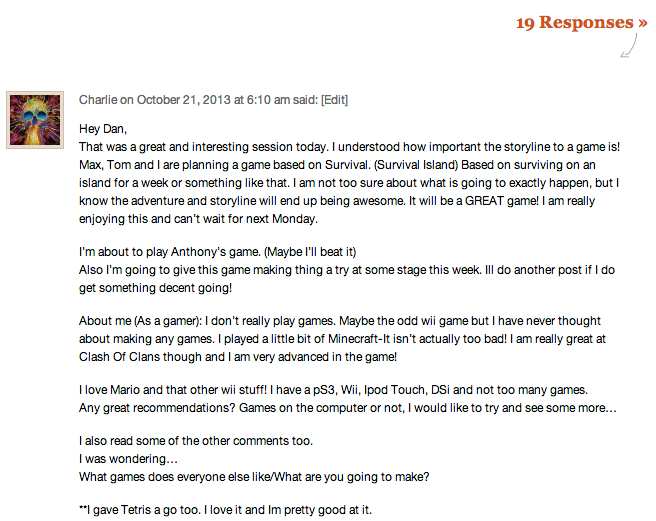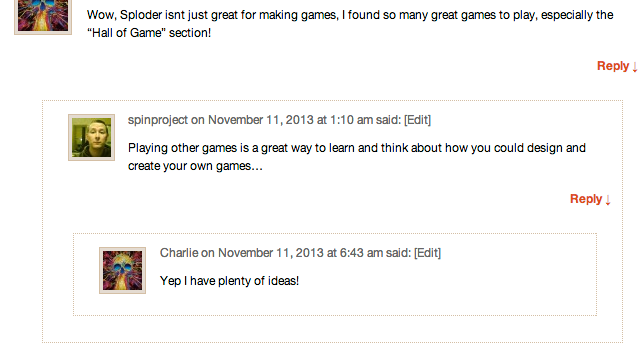As a Professional Development trainer, I have the privilege of working with a large number of teachers and students focussing on technology, learning and teaching. Recently, I have been working closely with a number of teachers on blogging in the classroom and how they might embrace this communication technology. Naturally some teachers have embraced the platform while others have initially shown some resistance. In the second group, those who have struggled with blogging, the resistance arises as a result of not fully understanding the mechanics of building in a digital space, but more importantly, their uncomfortableness with communicating in this space. Many teachers still feel nervous about being “on show”. There is also the prevailing view from our generation (educators in their thirties, forties and above) of the “large consequences” of voicing things in the online space. I am not sure how true that view is. However, because of this attitude, many “adult” teachers are reluctant to add any voice in an online space. This reluctance means they are not involved in the networks and communities of practice existing online and are missing many opportunities to gain new knowledge.
Alongside working with teachers, my role also gives me the opportunity to work closely with students. I have recently been involved in a term-long unit of work with my friend and fellow educator Dan Donahoo. We were working with a group of 30 children (aged 11) and we focussed on digital game making. Comparing and contrasting the student’s opinions and use of the digital world to those of the teachers I previously mentioned has been quite enlightening. As I mentioned, the focus of our unit is on game making and it is an exciting and totally engaging unit for these kids.
At the start of the project we quickly built the students a blog to help us communicate with them. As we are only with this class for one hour a week, I was looking for a space where they could potentially become involved with the project outside of the classroom and beyond our physical contact hours. Dan and I gave them no instruction on how to use a blog or what we expected of them in this space. Instead, we simply gave the students the URL and said it was available to them if they wanted to use it.
The subsequent six weeks, and the way the blog was used by the students, were incredibly informative regarding this younger generation’s ability to communicate in the online space. However, beyond learning about how students used the blog, it was quite interesting to note the reasons for their communication, how this related to learning and how that type of learning is quite different to some of our more traditional practices.
Allow me to give a few examples.
We met with a group and had our first learning session on a Monday afternoon. That first night there were already 19 comments left on the blog – this is a class of 25 and shows the ease with which they use this medium. There was little to no evidence of fear of leaving a comment, an opinion or asking a question. There was no feeling of “permanency” of their digital imprints, leading to a fear of learning from the environment – something I think we need to consider in our current approaches to “cyber safety”. Maybe it is time to stop condemning the young for permanent records of their youth and inexperience. Maybe it is time to embrace a different perspective.
You can note in the picture below that the students felt free to leave an opinion of our afternoon class (thankfully positive) and information about the subject is freely offered up, helping us, as educators, to get to know our students better.

This is the first thing that generally makes teachers nervous and is an issue that needs to be discussed at a faculty level if schools are moving towards a more contemporary learning environment. Students feel free these days to publicly discuss and rate your classes. They have been continually operating in an environment that encourages this – almost every website or social media site actively seeks peer review and asks for viewers to rate their site (think of the like button). Potentially it is time for educators to embrace the power of peer reviewing of their classes to collectively learn how to improve their classes. This form of transparency is something that is part of the digital culture. It is a reality and attention needs to be given to it by educational leaders to assist teachers to transition to this new culture. When the learning becomes transparent through online mediums, there are fantastic benefits from a student’s perspective – they can see the progression of their learning, it opens up the feedback channels to multiple feedback sources (rather than just the individual teacher), and so on. It also opens up many positive opportunities for teachers but can also force some changes. No longer will you be able to run the tired unit on The Ancient Egyptians every year. Parents and students will demand more from you and they now have their eyes right on your classes.
Secondly, Dan and I decided to upload a vague plan of where we were heading in the unit – a unit outline. A number of students had read all of the planned work and jumped ahead and started to work at the place they were ready and excited to begin with. They were rejecting our linear strategies and rather learning at the point of there own readiness. This really best represents how learning works – it is never linear. Perhaps some of the students had already covered our initial work in other classes or other parts of their life and did not require that from our plan. Excellent. Our idea of putting up the whole course content was also to encourage immersion into the work.

Potentially there would be kids who would take to this subject so keenly that they would like to do it in their own time, rather than be limited to our system of learning which only involved the one class a week at 2.30pm on a Monday afternoon. Thankfully, this did prove to be the case and it allowed for us as educators to stretch out and notice how it is important for our planning to be very flexible and dynamic. Kids were moving in directions beyond our planning and we needed to allow for that rather than constrict them to our initial limitations.
Finally, the blog was a great place for the children to push each other and provide feedback. Generally this student driven feedback contained knowledge far beyond that which Dan and I could have provided. The students would upload the games they were making and respond with critique both positive and negative to each other’s work. They would ask for immediate help and get quick responses rather than waiting for Dan or myself to be the sole assisters in their learning. Below, a student called Charlie expresses something he has learnt from his own investigations with the group allowing response from Dan and suggestions on how to move forward.

The following clip shows evidence of students uploading incomplete work, not afraid of public condemnation of poor work, but rather they are uploading it to generate learning – they are looking for advice which they subsequently received from other students, myself and Dan.

Blogging is not about “best work”, in fact, hardly anything on the internet is about “best work”. It is generally about rapid publishing and about joining a conversation. It is about active participation in networks. Through active participation, through having a voice and joining online conversation, we learn. The more one actively participates, the closer one gets to the centre of the network. The closer one is to the centre, the greater the ability to “co-create” new knowledge with the network. Imagine a world where our students were co-creating new knowledge rather than just sitting there having already existing content poured down upon on them. This world exists and our students are already actively participating in it. Blogging is one platform that allows for this active participation to occur.
A final word of encouragement for nervous teachers; while being one of the main educators involved in a game-making unit, I have never created a game in any of the platforms the students chose to use. I have used many others, but not these specific ones. As a teacher, you do not need to be an expert in software – you need to be able to set up learning environments that allow for a degree of student empowerment, allowing you to manage the environment and push the students to go deeper in their inquiries.

Kynan Robinson

Latest posts by Kynan Robinson (see all)
- Using Digital Gaming For Learning Outcomes - April 14, 2015
- Blogging From A Teacher’s Point Of View - April 8, 2014
- The Modern Learner: How Learning And Teaching Are Changing - January 22, 2014
You must be logged in to post a comment.


There are no comments
Add yours